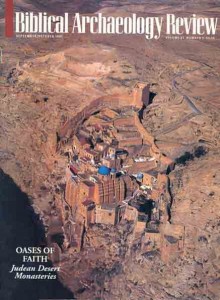A remarkable phenomenon swept Christianity soon after it triumphed as the official religion of the Roman empire: Devout adherents by the thousands, rather than staying at home to enjoy the faith’s comfortable new status, moved to the forbidding Judean desert to live austere lives as monks. Motivated in good part by the personal sacrifice of martyrs of previous generations, these newcomers to the Holy Land transformed the wilderness near Jerusalem into a hub of well-organized monastic communities. In recent years, young Israeli scholars have thoroughly revised our understanding of these communities and of the people who lived in them. Yizhar Hirschfeld, a prominent member of that group of scholars, describes several significant monasteries and how they embody “Spirituality in the Desert.”

Hirschfeld is lecturer of classical archaeology at the Hebrew University, Jerusalem. A Jerusalem native, he received his Ph.D. in archaeology in 1987 from the Hebrew University, where he completed his dissertation on the Judean desert monasteries in the Byzantine period. Among his major excavations are the Roman baths of Hammat Gader, farmsteads at Ramat Hanadiv near Caesarea, several monasteries in the Judean desert, and ancient Tiberias. He is about to begin excavation of Roman-Byzantine Ein Gedi. He is author of The Judean Desert Monasteries in the Byzantine Period (Yale Univ. Press, 1992); and The Palestinian Dwelling in the Roman-Byzantine Period (Franciscan Press and Israel Exploration Society, 1995).
Already a library member? Log in here.
Institution user? Log in with your IP address.

